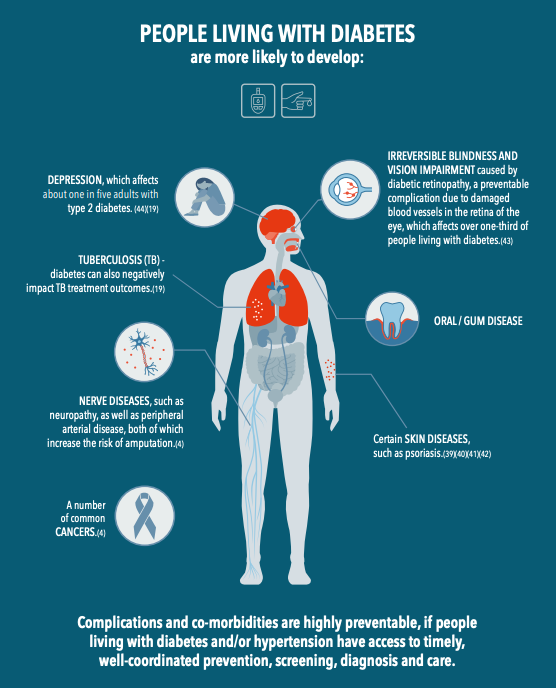Living with diabetes puts you at greater risk of 57 other diseases

We have long known that people living with diabetes have a higher risk of developing other serious health problems. A new study has put a number to those other issues — 57.
The study by the University of Cambridge found that people with type 2 diabetes have a higher risk of 57 other health conditions. These include cancer, kidney disease and neurological illnesses. On average, they develop the conditions five years sooner than other people, according to a press release from Diabetes UK.
9% higher risk of developing cancer
Researchers examined the health data of 3 million people above 30 years old (average age 50) in the largest study to date of health differences in middle age between those with and without type 2 diabetes. They assessed the link between type 2 diabetes and the incidence of 116 long-term, noncommunicable conditions that commonly affect UK adults in middle age.
Type 2 diabetes was linked to a higher incidence of 57 of the conditions. Notably, the research shows that those living with type 2 diabetes face the following risks:
- 9% more likely to get cancer
- 5.2 times more likely to have end-stage kidney disease
- 4.4 times more likely to have liver cancer
- 3.2 times more likely to have macular degeneration (loss of central vision)
- higher risk of developing 23 out of 31 circulatory conditions
“Preventing and delaying the onset of type 2 diabetes remains essential to reduce the likelihood of poor health in middle age,” said Dr Luanluan Sun, who co-led the study in her previous role as a clinical epidemiologist at Cambridge University.
The findings were presented at a recent conference hosted by Diabetes UK. They have not been peer-reviewed and the study is not yet publicly available.

Source: NCD Alliance
What is diabetes?
Diabetes occurs when the pancreas can no longer make insulin or when the body cannot make good use of the insulin it produces. About one in 10 people live with diabetes around the world. This number is predicted to rise from 537 million adults to 643 million and 784 million adults by 2030 and 2045. The large majority of these people live in low- and middle-income countries. Deaths from diabetes have increased by 70% since 2000.
Type 1 diabetes occurs most often in children and adolescents. At present, it cannot be prevented. Type 2 diabetes tends to develop in adulthood and accounts for around 90% of all diabetes cases. It can often be managed or prevented with a healthy lifestyle, including increased physical activity and healthy diet. Gestational diabetes refers to high blood glucose during pregnancy and is linked with complications for both mother and child.
The major cause of death and illness in people living with diabetes is heart disease, which is heightened by hypertension, or high blood pressure. Globally, 463 million people live with diabetes and 1.13 billion people are living with hypertension.
Common to live with diabetes and other diseases
Co-morbidity, or living with more than one chronic disease, is a feature of diabetes. At the time of their type 2 diabetes diagnosis, 75% of people had at least one other chronic condition and 44% had at least two other conditions. This is because many chronic conditions share key risk factors with diabetes, like obesity, vascular inflammation, and high cholesterol.
One example of treating co-morbidities comes from a recent policy paper by NCD Alliance and partners. The paper notes that diabetes and hypertension commonly occur together. Both are also linked to many other NCDs, due to complications or being triggered by the same risk factors. The paper argues that treating both diseases at the same time would yield greater positive results for wellbeing, health systems and sustainable development.
Covid-19 has shown the urgency of treating co-morbidities, notes the paper. “The majority of people who have died from COVID-19 were living with underlying NCD conditions, most commonly hypertension, cardiovascular disease or diabetes. People living with multiple chronic conditions have been found to be at significantly higher risk.”
Diabetes screening and treatment cost-effective
The Cambridge study grouped the 116 conditions into 11 clinical categories relating to different bodily systems. The highest risks were observed for conditions related to the:
- genitourinary system (2.6 times higher risk than people without diabetes)
- neurological system (2.6 times)
- eyes (2.3 times)
- digestive system (1.9 times)
- mental health (1.8 times), and
- circulatory system (1.6 times).
The risks of developing circulatory, genitourinary, neurological and eye conditions were much higher for people diagnosed with type 2 diabetes under the age of 50 years than people diagnosed at a later age.
“Type 2 diabetes and the complications that can lead from it are not inevitable,” said Dr Elizabeth Robertson, Director of Research at Diabetes UK. “That’s why it's so important that people at increased risk of type 2 diabetes are supported to reduce their risk, and that those living with the condition have continued access to routine care and support to manage it well and avoid or delay complications.”
This is why we need to invest more on diabetes prevention...
Diabetes screening and treatment is on a recently released list of 21 cost-effective actions that countries can take to reach the UN Sustainable Development Goal of cutting premature death from noncommunicable diseases by one-third by 2030.
The World Health Organization calculates that every dollar spent on the prevention and treatment of cardiovascular disease and diabetes saves $3.12 from additional health costs and lost economic activity.
In addition, investment in reducing the underlying risk factors for diabetes and other NCDs – particularly alcohol consumption, poor diet, tobacco use, and physical inactivity – on average yields seven dollars in savings for every one invested